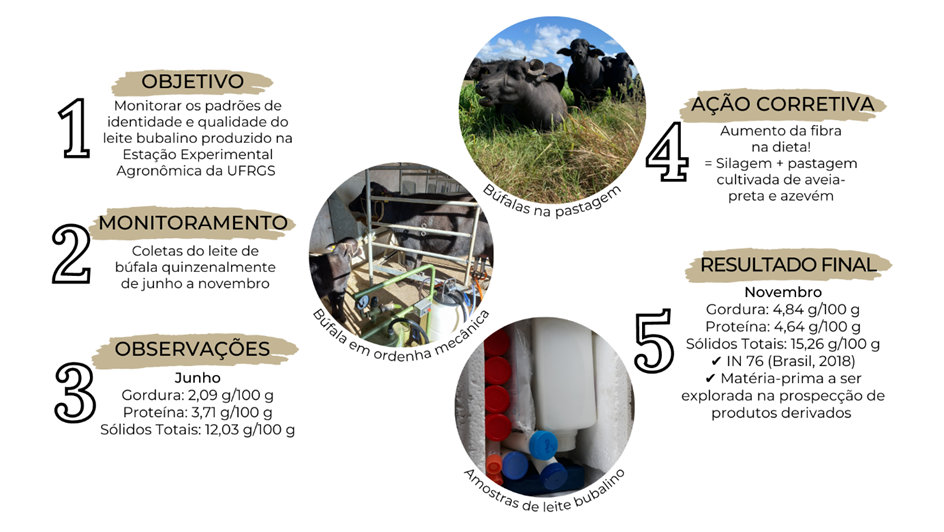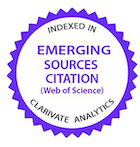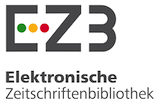Implementation of a milking system and quality management for buffalo milk at an experimental station in Rio Grande do Sul, Brazil
DOI:
https://doi.org/10.1590/1809-6891v24e-75499EAbstract
Buffalo milk production is an activity that has grown in recent years, mainly due to the physicochemical characteristics found in this type of milk, which is the second most produced in the world. The objective of this study was to implement a milking system and monitor the identity and quality standards of buffalo milk produced at the Experimental Agronomic Station of the Federal University of Rio Grande do Sul. Samples were collected fortnightly between June and November 2021, totaling ten collections. The means obtained at the end of the monitoring were 4.84 g/100 g for fat, 4.64 g/100 g for protein, 5.06 g/100 g for lactose, 15.26 g/100 g for total solids, 10.42 g/100g for non-fat solids, 0.18 g lactic acid/100 mL of milk for acidity, 1.037 g/cm³ for density, -0.533°C for cryoscopic index, 3.5 x 105 cells/mL for somatic cell count, and 8.0 x103 CFU/ml for standard plate count. Residues of antibiotics and antiparasitics were not found. An increase in the concentration and frequency of some fatty acids was observed, after an increment in the nutritional management of the animals, in addition to predominance of palmitic acid (C16:0) and oleic acid (C18:1- cis (n9)). The results indicate a significant improvement in the quality of the milk in the assessment period, due to the corrective actions that were established, and the standard plate count showed good agricultural practices as to milk sourcing and the hygiene of the materials, being below the limits required by NI 76. The buffalo milk produced by the herd at the Experimental Station showed physicochemical and microbiological results in accordance with the legislation, being a raw material to be explored in the prospection of derivative products.
Keywords: Bubalus bubalis; buffalo; good agricultural practices; raw milk.
Downloads
References
FAOSTAT. Food And Agriculture Organization of The United Nations Statistics. 2021. <http://faostat.fao.org/>
OECD/FAO. OECD-FAO Agricultural Outlook 2021-2030. OECD Publishing, Paris. 2021. <https://doi.org/10.1787/19428846-en>
Pignata MC, Fernandes SAA, Ferrão SPB, Faleiro AS, Conceição DG. Estudo comparativo da composição química, ácidos graxos e colesterol de leites de búfala e vaca. Revista Caatinga, Mossoró; 2014. v. 27, n. 4, p. 226 –233, out. –dez.
Godinho FMS, Krug M, Muller A, Jank L, Tomaszewski CA, Hillesheim DR, Kinast EJ, Frazzon APG, Motta AS. Microbiological and physicochemical characteristics of buffalo milk used for dairy products in southern Brazil. Journal of Dairy Research; 2020. v. 87, n. 4, pp. 463-468. Disponível em: https://doi.org/10.1017/S002202992000093X
Ménard O, Ahmad S, Rousseau F, Briard-Bion V, Gaucheron F, Lopez C. Buffalo vs. cow milk fat globules: Size distribution, zeta-potential, compositions in total fatty acids and in polar lipids from the milk fat globule membrane. Food Chemistry; 2010. 120;2:544-551. Disponível em: https://doi.org/10.1016/j.foodchem.2009.10.053
FAO e IDF. Guia de boas práticas na pecuária de leite. Produção e Saúde Animal Diretrizes; 2013. Roma.
Brasil. Ministério da Agricultura, Pecuária e Abastecimento. Instrução Normativa 76 de 26 de novembro de 2018. Dispõe sobre identidade e as características de qualidade que devem apresentar o leite cru refrigerado, o leite pasteurizado e o leite pasteurizado tipo A. Diário Oficial da União, Brasília, DF: Seção 1, 30 nov. 2018.
Domenico VL, Motta AS. Manual de Boas Práticas Agropecuárias na Ordenha: Bubalinocultura. Universidade Federal do Rio Grande do Sul; 2022.
ISO 13366-2. Milk – Enumeration of somatic cells – Part 2: Guidance on the operation of fluoro-opto-electronic counters. International Organization for Standardization; 2006. Geneva.
ISO 9622. Milk and liquid milk products – Guidelines for the application of mid-infrared spectrometry. International Organization for Standardization; 2013. Geneva.
MAPA. Manual de Métodos Oficiais para Análise de Alimentos de Origem Animal - Método 2.12; 2019. 2ª Edição.
MAPA. Manual de Métodos Oficiais para Análise de Alimentos de Origem Animal - Método 2.2; 2019. 2ª Edição.
ISO 5764. Milk — Determination of freezing point — Thermistor cryoscope method (Reference method). International Organization for Standardization; 2009. Geneva.
ISO 4833-1. Microbiology of the food chain – Horizontal method for the enumeration of microorganisms – Part 1: Colony count at 30 degrees C by the pour plate technique. International Organization for Standardization; 2013. Geneva.
Rübensam G, Barreto F, Hoff RB, Kist TL and Pizzolato TM. A liquid-liquid extraction procedure followed by a low temperature purification step for the analysis of macrocyclic lactones in milk by liquid chromatography-tandem mass spectrometry and fluorescence detection. Analytica Chimica Acta; 2011. 705, p. 24–29.
Jank L, Martins MT, Arsand JB, Motta TMC, Hoff RB, Barreto F and Pizzolato TM. High-throughput method for macrolides and lincosamides antibiotics residues analysis in milk and muscle using a simple liquid–liquid extraction technique and liquid chromatography–electrospray– tandem mass spectrometry analysis (LC–MS/MS). Talanta; 2015. 144, p. 686–695.
Barreto F, Ribeiro C, Hoff RB and Costa TD. Determination of chloramphenicol, thiamphenicol, florfenicol and florfenicol amine in poultry, swine, bovine and fish by liquid chromatography–tandem mass spectrometry. Journal of Chromatography; 2016. 1449, p. 48–53.
AOCS. Official methods and recommended practices of the American Oil Chemists’ Society. 2009.
São Paulo (Estado). Secretaria de Agricultura e Abastecimento. Resolução SAA nº 03 de 10 de janeiro de 2008: Normas técnicas sobre as condições higiênico-sanitárias mínimas necessárias para aprovação, funcionamento e reaparelhamento dos estabelecimentos destinados a leite e produtos lácteos; 2008. Artigo 134.
Thakur S , Singh M, Aseri GK, Verma A, and Khan SS. Isolation and characterization of mastitis pathogens and milk composition changes in Murrah buffaloes (Bubalus bubalis) during winter season. Indian Journal of Animal Research; 2018. 52(2), p. 276-280.
Filho MHBC, Júnior DML, Rangel AHN, Silva FJS, Novaes LP, Júnior JGBG, Silva MJMS, Moreno GMB. Season and buffalo milk quality in Rio Grande do Norte state. Acta Veterinaria Brasílica; 2014. 8, 201–208.
Pasquini M, Osimani A, Tavoletti S, Moreno I, Clementi F and Trobetta MF. Trends in the quality and hygiene parameters of bulk Italian Mediterranean buffalo (Bubalus bubalis) milk: A three year study. Animal Science Journal; 2017. 89, 176–185.
Tripaldi C, Palocci G, Miarelli M, Catta M, Orlandini S, Amatiste S, Bernardini R, Castillo G. Effects of mastitis on buffalo milk quality. Asian-Australasian Journal of Animal Sciences; 2010. 23, 1319–1324.
Medeiros ES, Barbosa SBP, Jatobá RB, Azevedo SS, Junior JWP, Saukas TN, de Albuquerque PPF, Mota RA. Perfil da contagem de células somáticas na infecção intramamária em búfalas na Região Nordeste do Brasil. Pequisa Veterinária Brasileira; 2011. 31, 219-223.
Balusami C. Milk constituents of non-descript and graded murrah buffaloes in Tamil Nadu, India. Indian Journal of Natural Sciences; 2015. 5:0976 – 0997, p. 2475-2479.
Bassbasi M, Platikanov S, Tauler R and Oussama A. FTIR-ATR determination of solid non fat (SNF) in raw milk using PLS and SVM chemometric methods. Food Chemistry; 2014. 146, 250–254.
Costa MHBFo, Lima DMJr, Rangel AHN, Silva FJS, Novaes LP, Galvão JGBJr, Silva MJM, Moreno GMB. Sazonalidade e variação na qualidade do leite de búfalas no Rio Grande do Norte. Acta Veterinaria Brasilica; 2014. 8, 201-208.
Bailone RL, Borra RC, Roça RO, Aguiar L, Harris M. Quality of refrigerated raw milk from buffalo cows (Bubalus bubalis bubalis) in different farms and seasons in Brazil. Ciência Animal Brasileira; 2017. 18, 1–12.
Hofi AA, Rifaat ID, Khorshid MA. Studies on some physico-chemical properties of Egyptian buffaloes and cows’ milk. I. Freezing point. Indian Journal of Dairy Science; 1966. 19:113-117.
Brasil. Ministério da Agricultura, Pecuária e Abastecimento. Depressão do Ponto de Congelamento do Leite Fluido. MET POA (Métodos de Ensaio Produtos de Origem Animal); 2011.
Pesce A, Salzano C, Felice A, Garofalo F, Liguori S, Santo A, Palermo P, Guarino A. Monitoring the freezing point of buffalo milk. Italian Journal of Food Safety; 2016. 5:5691.
Brasil. Agência Nacional de Vigilância Sanitária. Instrução Normativa Nº 51, de 19 de dezembro de 2019 - estabelece a lista de limites máximos de resíduos (LMR), ingestão diária aceitável (IDA) e dose de referência aguda (DRfA) para insumos farmacêuticos ativos (IFA) de medicamentos veterinários em alimentos de origem animal; 2019.
Kalač P & Samková E. The effects of feeding various forages on fatty acid composition of bovine milk fat: a review. Journal of Animal Science; 2010. 55: 521–537.
Bauman DE, Mcguire MA & Harvatin KJ. Mammary gland, milk biosynthesis and secretion. In: Encyclopedia of Dairy Sciences, 2011. Elsevier Inc., p. 352–358.
Ahmad S, Anjum FM, Huma N, Sameen A, Zahoor T. Composition and physico-chemical characteristics of buffalo milk with particular emphasis on lipids, proteins, minerals, enzymes and vitamins. Journal of Animal and Plant Sciences; 2013. Jan 1;23(Suppl 1): p. 62-74.
Gagliostro GA, Patiño EM, Sanchez Negrette M, Sager G, Castelli L, Antonacci LE, Raco F, Gallello L, Rodríguez MA, Cañameras C, Zampatti ML. 2015. Perfil de ácidos graxos do leite de búfalas a pasto recebendo uma mistura de óleo de soja e linhaça na dieta. Arquivo Brasileiro de Medicina Veterinária e Zootecnia; 2015. Maio;67: p. 927-34.
Balcao VM, Malcata FX. Lipase catalyzed modification of milkfat. Biotechnology advances; 1998. Mar 1;16(2):309-41.
Mihaylova, G., & Peeva, T. Trans fatty acids and conjugated linoleic acid in the buffalo milk. Italian Journal of Animal Science; 2007. v.6, p. 1056–1059.

Published
How to Cite
Issue
Section
License
Copyright (c) 2023 Brazilian Animal Science/ Ciência Animal Brasileira

This work is licensed under a Creative Commons Attribution 4.0 International License.
Authors who publish with this journal agree to the following terms:
- Authors retain copyright and grant the journal right of first publication with the work simultaneously licensed under a Creative Commons Attribution License that allows others to share the work with an acknowledgement of the work's authorship and initial publication in this journal.
- Authors are able to enter into separate, additional contractual arrangements for the non-exclusive distribution of the journal's published version of the work (e.g., post it to an institutional repository or publish it in a book), with an acknowledgement of its initial publication in this journal.
- Authors are permitted and encouraged to post their work online (e.g. in institutional repositories or on their website) prior to and during the submission process, as it can lead to productive exchanges, as well as earlier and greater citation of published work (See The Effect of Open Access).































